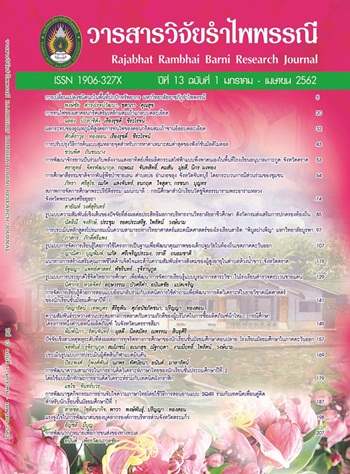การปรับปรุงวิธีการค้นแบบสุ่มหลายจุดสำหรับการหาค่าเหมาะสมต่ำสุดของ ฟังก์ชันมัลติโมดอล
Main Article Content
บทคัดย่อ
วิจัยนี้ศึกษาการปรับปรุงวิธีการค้นแบบสุ่มหลายจุดสำหรับค่าเหมาะสมต่ำสุดของฟังก์ชันมัลติโมดอล ซึ่งมีองค์ประกอบหลักคือ จำนวนประชากรที่ค้น ทิศทางของจุดที่ค้น ระยะกระโดด การดำเนินการเชิงประชากร และอัตราการแลกเปลี่ยนส่วนประกอบของเวกเตอร์ ซึ่งได้ทดลองกับฟังก์ชันทดสอบ 5 ฟังก์ชัน ที่มีจำนวนตัวแปร N=2, 5, 10, 20 และ 30 อัตราการแลกเปลี่ยนส่วนประกอบของเวกเตอร์ CR=0.1, 0.3, 0.5, 0.7 และ 0.9 และจำนวนประชากร NP=10, 30, 50, 70 และ 90 จากการศึกษาพบว่า อัตราการแลกเปลี่ยนส่วนประกอบของเวกเตอร์ CR=0.9 และจำนวนประชากร NP=50 เป็นค่าที่เหมาะสมต่ำสุดของฟังก์ชันมัลติโมดอล โดยการปรับปรุงวิธีการค้นแบบสุ่มหลายจุด
Article Details
ประเภทบทความ
บทความวิจัย
เอกสารอ้างอิง
1. Sheela, B.V. 1979. An Optimized step-size random Search (OSSRS). Computer Method in Applied Mechanics and Engineering.
2. Holland, J.H. 1975. Adaptation in Natural and Artificial Systems, University of Michigan Press, Ann Arbor, Michigan; re-issued by MIT Press.
3. Storn, R.N. and Price, K.N. 1997. Differential Evolution-A Simple and Efficient Heuristic for Global Optimization over Continuous Spaces. Journal of Global Optimization.
4. Mohamed, Ali W., Hegazy Z. Sabry and Motaz Khorshid. 2012. An alternative differential evolution algorithm for global optimization.
5. Zabinsky, Zelda B. 2009. Random Search Algorithms, Department ofIndustrial and Engineering, University of Washington. Seattle. April 5.
6. Price K., Storn R., and Lampinen J. 2005. Differential Evolution – A Practical Approach to Global Optimization, Springer. Berlin Heidelberg New York.
7. Sotiropoulos, D.G., Plagianakos, V.P. and Vrahatis, M.N. An Evolutionary Algorithm for Minimizing Multimodal Function, Department of Mathematics, Uiverity of Patras, GR-261.10 Patras, Greece. University of Patras Artificial Inteligence Research Center-UPAIRC.
8. Zelda B. Zabinsky. 2009. Random Search Algorithms, Department of Industrial and Systems Engineering, University of Washington, Seattle, Wa, 98195-2650, USA.
9. Francisco, J.Solis and Roger, J-B. Wets. 1981. Minimization By Random Search Techniques, Mathematics of Operations Research.
2. Holland, J.H. 1975. Adaptation in Natural and Artificial Systems, University of Michigan Press, Ann Arbor, Michigan; re-issued by MIT Press.
3. Storn, R.N. and Price, K.N. 1997. Differential Evolution-A Simple and Efficient Heuristic for Global Optimization over Continuous Spaces. Journal of Global Optimization.
4. Mohamed, Ali W., Hegazy Z. Sabry and Motaz Khorshid. 2012. An alternative differential evolution algorithm for global optimization.
5. Zabinsky, Zelda B. 2009. Random Search Algorithms, Department ofIndustrial and Engineering, University of Washington. Seattle. April 5.
6. Price K., Storn R., and Lampinen J. 2005. Differential Evolution – A Practical Approach to Global Optimization, Springer. Berlin Heidelberg New York.
7. Sotiropoulos, D.G., Plagianakos, V.P. and Vrahatis, M.N. An Evolutionary Algorithm for Minimizing Multimodal Function, Department of Mathematics, Uiverity of Patras, GR-261.10 Patras, Greece. University of Patras Artificial Inteligence Research Center-UPAIRC.
8. Zelda B. Zabinsky. 2009. Random Search Algorithms, Department of Industrial and Systems Engineering, University of Washington, Seattle, Wa, 98195-2650, USA.
9. Francisco, J.Solis and Roger, J-B. Wets. 1981. Minimization By Random Search Techniques, Mathematics of Operations Research.


